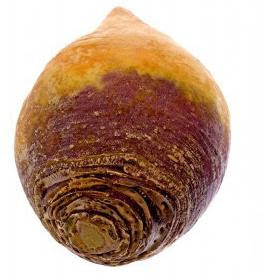Do you find cruciferous vegetables to be bitter? You probably have a genetic variant that allows you to taste a certain chemical (phenylthiocarbamide) which tastes bitter.
Carbohydrate and Fiber Counts for Turnips:
½ cup of raw turnip cubes: 3 grams of effective (net) carbohydrate plus 1 gram of fiber and 18 calories
1 medium turnip, a little over 4 oz (¼ lb): 6 grams of effective (net) carbohydrate plus 2 grams of fiber and 34 calories
½ cup of cooked mashed turnip: 3.5 grams of effective (net) carbohydrate plus 3 grams of fiber and 25 calories
Health Benefits of Turnips:
Turnips are an excellent source of vitamin C, a very good source of fiber, and a good source of potassium, manganese, calcium, and vitamin B6. Turnips are also cruciferous vegetables (also called brassicas or cole crops).
Cruciferous vegetables are high in glucosinolates, which are phytonutrients thought to be helpful in protecting our bodies from certain types of cancers. Glucosinates also have antimicrobial and anti-inflammatory properties.
Above details from here
The turnip or white turnip, is a root vegetable commonly grown in temperate climates worldwide for its white bulbous taproot.
Small, tender varieties are grown for human consumption, while larger varieties are grown as feed for livestock.
In the north of England and Scotland, and eastern Canada (Newfoundland), turnip (or neep; the word turnip is an old compound of tur- as in turned/rounded on a lathe and neep, derived from Latin napus) refers to the larger, yellow rutabaga root vegetable, also known as the "swede" (from "Swedish turnip")
There is evidence that the turnip was domesticated before the 15th century BC; it was grown in India at this time for its oil-bearing seeds
One medium raw turnip (122 g) contains the following nutritional elements:
Calories : 34
Fat: 0.12
Carbohydrates: 7.84
Fibers: 2.2
Protein: 1.10
Cholesterol: 0
These details from here
Swede Wonderful Swede - also known as 'Rutabaga' or 'Neeps'
Americans know it as "rutabaga". The Scottish call it "neeps" and serve it with haggis. The swede, a fairly recent root vegetable, is thought to have originated around the 17th century in Bohemia. In 1620 a Swiss botanist described the root vegetable, believed to be a hybrid of the cabbage and the turnip. By 1664 it was growing in England. A good source of vit.C, fibre, folate and potassium. Low in calories.Wash then peel thoroughly to remove the thick outer skin. Swede can be prepared and served in any of the methods used for potatoes. Swede can be added to soups, stews and casseroles. Use mashed swede instead of mashed potato it has a slightly sweet taste. Swede can also be made into fritters and pancakes. Collins Gem states 2.3 grams of carb per 100 grams. It doesn't spike blood sugar numbers like a potato may. Swede is just great, try it and see.
Above details from here
Why not put these vegetables on your shopping list soon!
All the best Jan



11 comments:
I was put off swede for a number of years after having it for school dinners. I don't know what they did in those kitchens but the food wasn't at all appetising. I'm glad I tried it again though as it's a great vegetable, one we all enjoy.
I really like turnips but peeling them is a pain. Thanks again guys for the recipes. Wishing you an amazing day out there.
Turnips are wonderful--I love both the root and the leaves. They can be grated and stir fried or cubed and added with other root vegetables like carrots and potatoes and placed in a bag with herbs and olive oil and then baked.
Hi Jo
I'm so glad you, and the family, like swede now.
We all love it in our family too ... especially mashed swede with plenty of butter.
Quite Yum!
Hope your week is going well
All the best Jan
Hi Nikki (Sarah)
I think both turnips and swede are not always easy to peel and care should be taken ... but once they are peeled and cooked they are so worth it!
Many thanks for your comments and good wishes
All the best Jan
Hi Sage
So great to see you say you love both the root and the leaves!
Many thanks for your hints and tips ...
All the best Jan
These have always been my favorite vegetables.
Hi,
My mom loves rutabaga.
I have never tasted a turnip. I must try one this season. :-)
Carla
Hi Denise
Many thanks for your comments both here and on other posts too.
Yes, these vegetables are great aren't they, and can be used with many recipe plans.
All the best Jan
Hi Carla
"My mom loves rutabaga" ... she knows a good vegetable when she's eating it!
There are some lovely vegetables available that offer a lower carb alternative, hope you get to try turnip soon.
Thanks so much for your comment and continued support of the low carb diabetic blog.
All the best Jan
As you know, I'm not a fan of low-carb living for myself, but I do enjoy these veggies just the same. So much yum. So little time.
Post a Comment